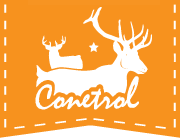 |
 |
|
| |
 |
| - See the Numbered Sections Below - |
| SECTION 1: Quick and easy way to mount rings and scope once base has been installed. |
| SECTION 2: Quick and easy way to eliminate reticle cant after scope has been mounted. |
| SECTION 3: Removing a Conetrol-mounted scope. |
| SECTION 4: Sorting Conetrol ring parts that may have become mixed. |
| Installing Your Scope with Conetrol Projectionless Rings | |||
 |
After you've attached the Conetrol base to your gun: 1. Open only one ring box at a time, the sure-fire way to keep from mixing ring parts. At the factory, Conetrol projectionless rings are individually mounted and polished as an intact unit for a perfect fit. |
||
| 4. Now, open the other ring box and install the second ring on the scope to fit into the Conetrol base. 5. Proceed to the "Mounting the Scope" section of the instruction sheet packaged with your Conetrol base. |
|||
| Eliminating Reticle Cant with Conetrol Projectionless Rings | |||
 |
After you've mounted your scope on your gun and have tightened the cone screws of the Conetrol mount: 1. Loosen both cone screws under the front ring, and back the two cone screws about halfway out. (With Limited or Custum rings, also loosen the
two ring-stud screws at the base of each ring.) |
||
| 4. Now loosen the cone screws under the rear ring and back them about halfway out. 5. Back at the front ring (the corrected one), tighten its cone screws, pulling the front ring firmly down and flat on the Conetrol base. 6. Finally, straighten out the still-loose rear ring by bumping it with heel of your hand until it is again seated flat on top of the Conetrol base. Then tighten both cone-screws. 7. Repeat steps 1 through 6 if the scope/reticle cant still needs correction. When finished, remember to tighten the ring-stud screws on Limited and Custum rings. |
|||
| Removing Scope and Rings from a Conetrol Projectionless Mount | |||
 |
If you have a gun and scope with a Conetrol mount:
1. Unscrew, about halfway, all four cone screws in the sides of the Conetrol base. |
||
| Hints for Sorting Through Conetrol Projectionless Rings if the Parts Have Been Mixed | |||
 |
Every Conetrol projectionless ring is individually mounted and polished as an intact unit for a perfect fit. If you suspect your ring parts may be mixed, maybe these tips will help: 1. A number is stamped on the very bottom of one ring half only, not the other. If you have a ring with a number on both halves, or a ring with no numbers at all, those halves do not belong together. For 1" rings, the number 4 indicates a low ring (4/64"), 8 a medium ring (8/64"), and 12 a high ring (12/64"). For 30mm rings, 30 indicates low (3mm), 50 medium (5mm), and 70 high (7mm). 2. A cap-locating notch is ground at the top of one ring half and not the other. If you have a ring with a notch on both halves, or a ring with no notches at all, those halves do not belong together. |
||
|
3. Hold the ring halves in position together and look closely at the top and bottom. If the width of the ring is not exactly the same at both top and bottom, those halves do not belong together.
4. Each ring is bored before it is split. The interior boring marks are generally discernible and should continue across the splits from one ring half to the other at both top and bottom when the ring halves are held in position together. If the boring lines do not coincide, those halves do not belong together. 5. In the finishing process, the circular dovetail at the top of a pair of ring halves is relieved fore and aft with a hand grinder so the cap will go on. This is done in a single operation, with the top edges of the ring halves pushed together as if in position around a scope tube. If it is apparent that the halves of a split dovetail atop a set of ring halves held together were not ground at one and the same time, those ring halves do not belong together. 6. Circular machining marks are usually discernible at the top and/or bottom of each pair of ring halves, which may change slightly from one ring to another. If such machining marks are discernible at either the top or bottom of one half, the same pattern should be visible on the other. On the other hand, if the cut is very smooth at the top or bottom of one ring half, it should also be smooth on the other half. If such machining patterns do not match up, the ring halves do not belong together. 7. Once you have a pair of ring halves you know belong together, add the cap and check for a good fit. If the locating notches on the cap and ring-half are held together, the fit should be precise, with the small flats at the front and back edges of the cap lining up exactly with the front and back edges of the ring. If the cap overhangs even slightly at the front or back, or is not quite as wide as the ring, that cap does not belong with those ring halves. 8. Finally, if you think you've just about got all the parts of two separate rings sorted out, try this last test: switch caps. Sometimes a cap on one ring will seem just right and the cap on the other ring will look good enough, but switching caps will suddenly make everything just right. Then you know you're right! |
|||
| email@conetrol.com | 830-379-3030 |